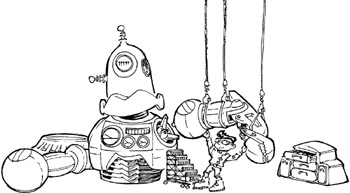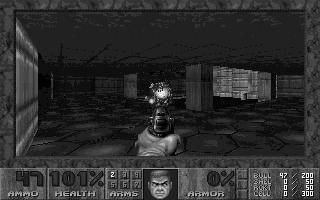Chapter 15: Getting the Gameplay Working
Overview

Those who wish to be must put aside the alienation, get on with the fascination, the real relation, the underlying theme.
” Neil Peart
Hollywood has a system. It is a well-known system with a well-defined goal, where the largest unknown is Where is the money coming from? not How will we ever make this film? Hollywood producers and talent know how to go from a treatment to a script, through multiple revisions of that script, then how to bring together the personnel that will shoot the film, and finally a smaller team that will edit it, culminating in the completion of the film on time and on budget (usually). Hollywood as a whole has much less of a handle on whether the final film will be any good or not, but they do at least know how to get the film made. Seldom does a film already in production have its script completely rewritten, its personnel trimmed , or more people added willy-nilly to its cast and crew. Customarily, films are completed months and months before they are scheduled to be released. Granted, sometimes the film may never make it beyond the script stage or, once completed, may not get released as originally intended. But, overall, Hollywood has an efficient system for creating films .
On the other hand, computer game developers have no such system. The development of a game design is a chaotic and unpredictable process filled with problems not even the most experienced producer, designer, or programmer can foresee.
Customarily, development on computer games continues until the absolute last possible second, with changes made right up to the time the gold master disc is shipped to the duplicators. For PC games, usually a patch follows shortly thereafter, since the game was never properly finished in the first place. Why is computer game development so unpredictable while film production is so predictable? Granted, Hollywood has been making movies for a lot longer than the computer game industry has been making games , which gives them a leg up. But beyond that, Hollywood is making a much more predictable product. Different movies may have unique stories and characters , and may even use a variation on cinematic techniques, but much of filmmaking is a known quantity.

Doom offered gameplay so different from any game that came before it that the game s development was something of a bold experiment.
Original games, on the other hand, are a totally new animal every time. Part of the problem is the shifting technology targets, where programmers must learn about new consoles, operating systems, and 3D accelerator cards for each project. Add to that the fact that so many games feel the need to have a cutting-edge graphics engine. But purely from a design standpoint, a truly original game is far more unique compared to other contemporary games than a movie is to other films being made at the same time. Consider games like Civilization, The Sims , or Doom . The gameplay contained in these games was radically different from anything that came before them. Granted, many games are far less experimental and innovative than the games I just listed, and games that have followed more of a formula have had a much better success rate in terms of coming out on time and on budget. This includes titles such as the Infocom adventure games, the Sierra adventure titles, the annual revisions of sports games, or the new versions of arcade driving games. However, these are games that, though including new content consisting of new stories and graphics, offer gameplay very much the same as the previous year s offerings. When a game tries to implement a new form of gameplay, even if it is only a variation on a proven theme, all hope of predictability in its development is thrown to the four winds.
Only truly talented designers have any hope of predicting what is going to be fun or not in a game, and even the most experienced designers will tell you that they use a lot of prototyping, experimentation, and general floundering around until they come up with the gameplay they want. These talented veteran designers do not have crystal balls; they only have an improved chance of anticipating what will make for compelling gameplay. They do not truly know more than anyone else.
The closest thing game development has to a reliable system for developing an original game is to get some small part of the gameplay working first, before moving ahead to build the rest of the game. This may be called a prototype, a demo, a proof-of-concept, a level, or simply the current build of the game. This is not merely a demo to show off the game s technology. Instead, it is something that shows off the game s gameplay, which incorporates preliminary versions of all the features described in the game s focus, as discussed in Chapter 5. This demo should be something any member of the development team can pick up, play, and say, Yes, this is fun, I want to play this. By concentrating on getting a small piece of the game fully functional and enjoyable, the developer can get a much better sense of whether the final game is going to be any fun or not. If the gameplay just does not turn out as anticipated, the prototype provides an early enough warning that the game needs to either be redirected in a more promising direction or, in the worst cases, aborted entirely.
EAN: 2147483647
Pages: 189